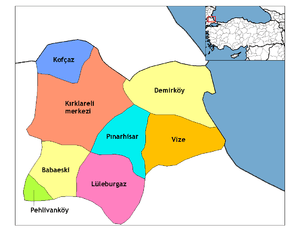Vize
Vize (Greek: Βιζύη, Bulgarian: Виза) is a town and district of Kırklareli Province in the Marmara region of Turkey. District's governor is Savaş Ünlü, and the mayor is Sedat Balkı (MHP). In 2010 the population of the town was 12,196 and the district 29,153. The town's distance to the province center is 56 km (35 mi). Vize is situated on the state road ![]()
Vize | |
|---|---|
District | |
 Vize Location in Turkey | |
| Coordinates: 41°34′25″N 27°45′55″E | |
| Country | |
| Region | Marmara |
| Province | Kırklareli Province |
| District | 1922 |
| Municipality | 1923 |
| Government | |
| • Governor | Savaş Ünlü |
| • Mayor | Sedat Balkı (MHP) |
| Area | |
| • District | 1,090.63 km2 (421.09 sq mi) |
| Elevation | 168 m (551 ft) |
| Population (2012)[2] | |
| • Urban | 12,543 |
| • District | 28,228 |
| • District density | 26/km2 (67/sq mi) |
| Time zone | UTC+2 (EET) |
| • Summer (DST) | UTC+3 (EEST) |
| Postal code | 39400, 39410, 39460, 39480 |
| Area code(s) | 0 288 |
| Licence plate | 39 |
| Website | www |
History
Vize, under the ancient name Bizya or Bizye (Ancient Greek: Βιζύη) served as capital for the ancient Thracian tribe of the Asti, and was mentioned by several ancient authors.[4][5] The acropolis section up on the hill above the town has some ancient buildings and a perfectly preserved Byzantine Church of Haghia Sophia from probably the 5th or 6th century AD.[6] Also, on the slope of the acropolis was recently found the remains of its ancient theater. Vize with its beautiful setting on the hilltop is in a commanding position over the surrounding area. Across the plain from the town are many burial mounds built for the rulers of Thracian Kingdom. There are some more churches and monasteries, mainly from the Byzantine era, in the neighborhood of Vize. The town also has some Ottoman structures, in addition to an ancient synagogue.
According to the Ottoman population statistics of 1914, the kaza of Vize had a total population of 14.109, consisting of 10.020 Muslims and 4.089 Greeks.[7]
Places of interest
Little Hagia Sophia Church (Gazi Suleiman Pasha Mosque) (Turkish: Küçük Ayasofya Kilisesi (Gazi Süleyman Paşa Camii)) is a former Byzantine era Orthodox church built during Emperor Justinian I (reigned 527-565) times, which was converted later in the Ottoman era into a mosque. Designed in an Orthodox Basilica plan, the church was constructed upon the foundations of the Temple of Apollo with masonry stone and brick. The cruciform shaped church consists of a nave with two rows of columns with three columns each, two aisles and an apse at one end. Its original wooden roof was replaced in the 12th and 13th centuries by a high dome. The building is vaulted around the dome, a different style that is normally not seen in Byzantian architecture.[8]
Vize Fortress (Turkish: Vize Kalesi) is a fortification constructed in the Ancient Roman era. It is situated at the northwest of the town. It is believed that the fortress was built originally in 72-76 B.C., and was revived during the Justinian I times. It is constructed of clear cut stones and rubble masonry upon foundations with stone blocks of 50 cm × 80 cm (20 in × 31 in) and 100 cm × 150 cm (39 in × 59 in). The bluish color of the stones at the northern wall indicates that this section was rebuilt in the Late Byzantine era during the Palaeologian dynasty. The fortress consists of two nested walls. The western and southern city walls are intact. An inscription in Greek alphabet letters carved on stone, which was found at the fortress, says "Here were watchtowers built under the administration of Firmus, the son of Aulus Pores, along with Aulus Kenthes, the son of Rytes the son of Kenthes, and Rabdus, the son of Hyakinthus." It is exhibited at Kırklareli Museum.[9]
Amphitheatre (Turkish: Antik tiyatro) is an open-air theatre built in the 2nd century during the Late Roman era, the only known one in Thrace. It was discovered in 1998 during archaeological excavations carried out for Çömlektepe tumulus. Parts of the Roman theatre, which still exist, are the cavea (spectators' seats) with aisles between the seats, the scaenae (stage) and orchestra. Reliefs from the scaenae frons, the background of the stage, are exhibited in the Kırklareli Museum.[10]
Image gallery
- Hasan Bey Mosque
- A watchtower at city walls
- A street in Vize
References
- "Area of regions (including lakes), km²". Regional Statistics Database. Turkish Statistical Institute. 2002. Retrieved 2013-03-05.
- "Population of province/district centers and towns/villages by districts - 2012". Address Based Population Registration System (ABPRS) Database. Turkish Statistical Institute. Retrieved 2013-02-27.
- "Vize Belediyesi" (in Turkish). Yerel Net. Retrieved 2011-12-17.
- Pliny. Naturalis Historia. 4.18.
- Stephanus of Byzantium. Ethnica. s.v. Βιζύη.
- Byzantine Church - Ottoman Mosque - Endangered Architectural Monument: An Architectural and Archaeological Survey of the Hagia Sophia at Vize
- Kemal Karpat (1985), Ottoman Population, 1830-1914, Demographic and Social Characteristics, The University of Wisconsin Press, p. 170-171
- "Küçük Ayasofya Kilisesi (Süleyman Paşa Camii)" (in Turkish). vize.com. 2006-04-05. Retrieved 2011-12-18.
- "Vize Kalesi" (in Turkish). vize.com. 2006-04-05. Retrieved 2011-12-18.
- "Antik Tiyatro (Odeon)" (in Turkish). vize.com. 2006-04-05. Retrieved 2011-12-18.
External links
| Wikimedia Commons has media related to Vize. |
